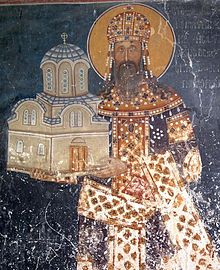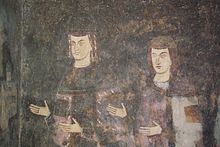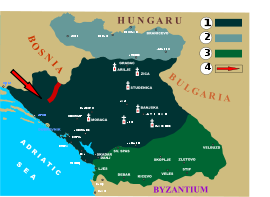- Stephen Uroš II Milutin of Serbia
-
For the Serb Grand Prince 1140-1161, see Uroš II Prvoslav.
Stephen Uroš II Milutin Nemanjić
Стефан Урош II Милутин НемањићKing of all the Serbian and Maritime Lands 
Fresco of king Milutin, King's Church of the Studenica monasteryReign 1282–1321 Coronation 1282 Birth name Uroš II Milutin Nemanjić Born 1253 Died October 29, 1321 (aged 68) Buried St. Nedelya in Sofia (relocated in 1460) Predecessor Stephen Dragutin Successor Stephen of Dečani Offspring Stephen Constantine, Stephen Uroš III Dečanski Royal House House of Nemanjić Father Stefan Uroš I Mother Hélène d'Anjou Religious beliefs Serbian Orthodox Stefan Uroš II Milutin (Serbian Cyrillic: Стефан Урош II Милутин) (c. 1253 – October 29, 1321) was a king of Serbia (reigned 1282–1321), and member of the House of Nemanjić.
Contents
Early
He was the youngest son of King Stefan Uroš I and his wife, Queen Helena (Hélène d'Anjou) from The House of Anjou. Unexpectedly he became king of Serbia after the abdication of his brother Stefan Dragutin. He was around 29. Immediately upon his accession to the throne he attacked Byzantine lands in Macedonia. In 1282, he conquered the northern parts of Macedonia with the city of Skoplje, which became his capital. Byzantine Emperor Michael VIII Palaiologos began preparations for war but he died before their completion. The next year Milutin advanced with his brother deep into Byzantine territory all the way to Kavala. In 1284, Milutin also gained control of northern Albania and the city of Dyrrachion (Durrës). For the next 15 years there were no changes in the war. Peace was concluded in 1299 when Milutin kept the conquered lands as the dowry of Simonis, daughter of Emperor Andronikos II Palaiologos who became his 4th wife.
War with the Tatars
After 1280 a Bulgarian prince named Shishman came to rule the semi-independent principality of Vidin. Shishman was a vassal of Nogai Khan, Khan of the Golden Horde and sought to expand his territories to the west, invading Serbia coming as far as Hvosno, the Tatars failed to capture Zdrelo (near Peć) and were pursued back to Vidin by the Serbs. Milutin devastated Vidin and the rest of Shishman's dominion, making Shishman take refuge on the other side of the Danube. The two however became allies after Milutin married Serbian župan Dragoš to the daughter of Shishman, later Milutin would give his daughter Anna to Shishman's son Michael who would become the Tsar of Bulgaria in 1323. Milutin and Nogai Khan would soon come in conflict because of the loss of Vidin, Nogai launched a campaign against Serbia but Milutin offered peace after sending his son Stefan Dečanski to Nogai's court, Stefan stayed with his entourage there until 1296 or Nogai Khan's death in 1299.[1]
Feud of the brothers


Young Dragutin and Milutin, Fresco of Sopoćani. Disputes began between Milutin and his brother Stefan Dragutin after a peace treaty with the Byzantine Empire was signed in 1299. Dragutin in the meantime held lands from Braničevo in the east to the Bosna river in the west. His capital was Belgrade. War broke out between the brothers and lasted, with sporadic cease-fires, until Dragutin's death in 1314. During this war Milutin appointed Stefan Dečanski as regent in Zeta, modern Montenegro. This meant that Stefan Dečanski was to be heir to the throne in Serbia and not Dragutin's son Stefan Vladislav II.
Battles and supreme leadership
He captured Durres in 1296.[2] The Battle of Gallipoli (1312) was fought by the Serbian troops sent by Stefan Uroš II Milutin to aid the Byzantine Emperor Andronikos in the defense of his lands against the Ottoman Turks. After numerous attempts in subduing the Turks, the rapidly crumbling Byzantine Empire was forced to enlist the help of Serbia. The Turks were looting and pillaging the countryside and the two armies converged at the Gallipoli peninsula where the Ottomans were decisively defeated. Out of the gratitude to Serbia, the town of Kucovo was donated to the Serbs.
Upon Stefan Dragutin's death in 1314 Milutin conquered most of his lands including Belgrade. But in 1319 Charles I of Hungary regained control over Belgrade and banovina Mačva while Milutin held control in Braničevo. In the year 1314 Milutin's son Stefan Dečanski rebelled against his father, but was captured, blinded and sent to exile in Constantinople. For the rest of Milutin's reign his youngest son Stefan Constantine was considered as heir to the throne, but in the spring of 1321 Stefan Dečanski returned to Serbia and was pardoned by his father.
Death and legacy
At the end of Milutin's life many things changed in Serbia. Serbia was one of the strongest countries in south-eastern Europe, except for Hungary. During his reign many court ceremonials were taken over from the Byzantine court and Byzantine culture overflowed into Serbia. Milutin was also well known as the founder of many monasteries: Gračanica monastery, Our Lady of Ljeviš, the church of Vavedenje in Hilandar and many more. After his death a short civil war followed, after which the Serbian throne was ascended by his eldest son, Stefan Dečanski.
Family
By his first wife, Helena, daughter of sebastokratōr John I Doukas of Byzantine ruler of Thessaly and Hypomone, he had no children.
By his second wife, Elizabeth, daughter of King Stephen V of Hungary and Elizabeth the Cuman, Milutin had:
- Stephen Constantine, rival king of Serbia from 1321 to 1322
By his third wife, Anna, the daughter of George I of Bulgaria, Stefan Uroš II Milutin had the following children:
- Stefan Uroš III Dečanski, who succeeded as king
- Anna Neda, who married Michael Shishman of Bulgaria
- Zorica, known as Tsaritsa (Empress)
By his fourth wife Simonis, the daughter of Emperor Andronikos II Palaiologos, he had no children.
Stephen Uroš II Milutin of SerbiaBorn: 1253 Died: 29 October 1321Regnal titles Preceded by
Stefan DragutinKing of Serbia
1282–1321Succeeded by
Stefan Uroš III DečanskiGallery
-
Fresco of young Milutin, Sopoćani
-
Lithograph of king Milutin by Anastas Jovanović, 1852
-
Relics of Milutin in the St Nedelya Church, Sofia
References
- John V.A. Fine, Jr., The Late Medieval Balkans, Ann Arbor, 1987.
- Group of authors, "History of Serbian people I-III", Belgrade 1994.
 House of Nemanjić
House of Nemanjić 
Main ruling members see family tree · Stefan Nemanja · Stefan Prvovenčani · Vukan Nemanjić · Stefan Radoslav · Stefan Vladislav I · Stefan Uroš I · Stefan Dragutin · Stefan (Uroš II) Milutin · Stefan Vladislav II · Stefan (Uroš III) Dečanski · Stefan (Uroš IV) Dušan · Stefan Uroš VOther ruling members Archbishops Minor members Vratislav Nemanjić · Vratko Nemanjić · Urošica · Dmitar Nemanjić · Stefan Vukanović · Radoslav Hlapenx · Vojihnax · Balša IxFemale members Jefimija · Komnena · Jelena Šubić · Jelisaveta · Anna Neda Shishman · Theodora · Milica · St. Jelena of DečaniConsorts St. Anastasija · Eudokia Angelina · Anna Dandolo · Anna Doukaina · Beloslava · Helen of Anjou · Catherine · Helena Doukaina Angelina · Elisabeth · Anna Terter · Simonida · Theodora Smilets · Maria Palaiologina · Helena · Anna BasarabaMonarchs of Serbia 1st Serbian Principality 641–969 Unknown Archont · Višeslav · Radoslav · Prosigoj · Vlastimir · Mutimir · Pribislav · Petar · Pavle · Zaharija · Časlav · annexation, Duklja emerging as seat2nd Serbian Principality
(Duklja)998–1101 Jovan Vladimir · Stefan Vojislav · Mihailo I · Constantine Bodin · Rascia re-emerging as seat (Grand Principality of Serbia)Serbian Grand Principality 1101–1217Vukan · Uroš I · Uroš II · Beloš · Desa · Tihomir · Stefan Nemanja · Stefan II · Proclamation of KingdomSerbian Kingdom 1217–1346Stefan II · Stefan Radoslav · Stefan Vladislav I · Stefan Uroš I · Stefan Dragutin ( · Stefan Vladislav II at Syrmia) · Stefan Uroš II Milutin · Stefan Konstantin · Stefan Uroš III Dečanski · Stefan Uroš IV Dušan · Proclamation of EmpireSerbian Empire 1346–1371Serbian Lordship and Despotate 1371–1537Lazar · Stefan Lazarević · Đurađ Branković · Lazar Branković · Stefan Branković · Stefan Tomašević · Ottoman annexation, titular: · Vuk Grgurević · Đorđe Branković · Jovan Branković · Ivaniš Berislavić · Stevan Berislavić · Radič Božić · Pavle Bakić · Stefan Štiljanović · Ottoman annexationRevolutionary Serbia 1804–1837Principality of Serbia 1837–1882Miloš I · Milan II · Mihailo III · Aleksandar · Miloš I · Mihailo III · Milan IV · Proclamation of KingdomKingdom of Serbia 1882–1918Milan I · Alexander · Petar I · Proclamation of Kingdom of Yugoslavia · Proclamation of SFR YugoslaviaCategories:- House of Nemanjić
- 1321 deaths
- 13th-century Serbian monarchs
- 14th-century Serbian monarchs
- 13th-century rulers in Europe
- 14th-century rulers in Europe
- Orthodox monarchs
- Rulers of Montenegro
- Burials at St Nedelya Church
Wikimedia Foundation. 2010.






